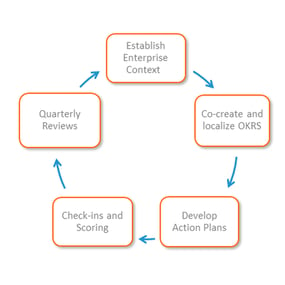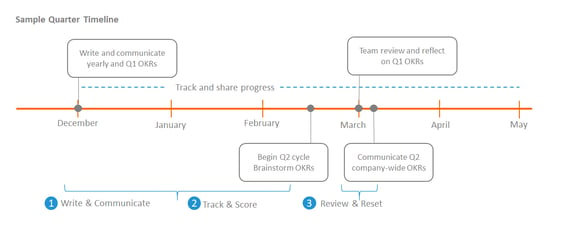
Have you heard of OKRs? Is your organization considering adopting OKRs? If so, this post is for you.
OKR stands for Objectives and Key Results. Andy Grove created them while at Intel, and they’ve been growing in their use ever since. The Objective equals the “what” we will achieve, and the Key Result is the benchmark we use to measure how we are doing.
OKRs have been working for organizations like Google and Intel for years. Implementing them for your organization can help drive focus and alignment around working on the right things. While anyone can read the book Measure What Matters, by John Doerr to learn how to write OKRs, it is by following a tried-and-true implementation plan that OKRs truly help organizations achieve the desired focus.
According to Scaled OKRs, Inc. the following key steps should be included:
- Build the team
- Communicate
- Train
- Execute the OKR cycle
- Calibrate Regularly
- Continue to the next OKR cycle
Step 1: Build the team
Build a team to lead the implementation of OKRs. Identify a sponsor and champion. These leaders should understand how keeping OKRs visible throughout the organization will lead to success. As with any change, practicing good change management is important. Introducing OKRs is no exception. Be sure to include a change manager in your team. In addition, your team should include someone familiar with how to write OKRs to guide and mentor those new to writing them.
Step 2: Communicate
Once you have identified the team that will lead and support implementing OKRs, the next step is all about change management communications. Your first communication should occur about two months before roll-out. In your communication, be sure and answer the questions, Why OKRs? And why now? Aside from creating a sense of urgency to adopt, create a vision for the change and share it out too. Have the communication come from Leadership to show the importance of implementing OKRs. Our change manager follows the Prosci ADKAR Model. The next message should come about one month prior to the roll-out and should be the formal kick-off announcement of the OKR process. Followed shortly by sharing the company level OKRs, and training workshops schedule.
Step 3: Train
Next, you’ll need to do some training. While OKRs may seem easy to write, putting pen to paper and coming up with the right OKRs can be a daunting task. A training workshop with a writing exercise will help attendees get orientated around what makes good OKRs. Here they will learn that the objective is qualitative, and the Key Results are quantitative. You may need a train-the-trainer session to enable others to assist teams in writing their OKRs. I like to share John Doerr’s “Super Powers” of OKRS as a reminder. These include:
- Focus & commit to priorities
- Align & connect teamwork
- Track for accountability
- Stretch for amazing
Step 4: Execute the OKR Cycle
With company OKRs in hand and training underway, the next step is to start the OKR Cycle.
In this cycle, teams write and share their OKRs to ensure vertical and horizontal alignment.
The Enterprise Context grounds teams to the highest level OKRs that were developed by leadership. This gives everyone something to tie their OKRs to and sets the direction for the organization. This allows teams to work on co-creating the localized OKRs.
The OKR Cycle looks like this:

The next step is for individual teams to write their localized OKRs. When it comes to writing OKRs, one of my favorite tips for writing OKRs is that you should be able to read them in the following format:
We will achieve (objective), as measured by (Key result).
Before everyone starts writing OKRS, you may want to think about how they will be kept. If you haven’t picked a tool to manage your OKRs, writing them in a shareable manner can become difficult. It’s easy enough to share across one or two verticals and even one or two horizontals. However, the more widely your OKR implementation, the more imperative a tool becomes.
Once the teams have created their OKRs, it’s time for them to develop their “Action plan,” or backlog of epics they will use to accomplish their OKRs. As part of an action plan, identify key result owners, and the frequency of review huddles. You’ll want a regular cadence of review. This step can be done at Scrum events, like the Sprint Review. The worst thing that can happen is to write OKRs and then forget about them. Finally, identify what scoring mechanism will be used.
Around the second month of the OKR cycle, check-ins and scoring occur. Many organizations follow Google’s lead when it comes to scoring. In their system, 0 is a failure, and 1 is a success. Here is a view of what the scores look like:

Figure 1: https://www.whatmatters.com/faqs/how-to-grade-okrs
You can see from this scale that a .7 is green. It is considered a success. This is especially true for OKRs that are ambitious and represent a real stretch for the team. A team that consistently gets a 1.0 could be considered as not creating ambitious enough OKRs.

In the timeline above, we allocated four weeks to work on the first set of OKRs and two weeks for subsequent quarters. The first draft of OKRs tends to take the longest. Be sure and allocate plenty of time for creating your first set of OKRs.
One last comment about this cycle, tracking and sharing progress is an ongoing effort. All-hands meetings are great places to talk about progress. This will keep them from being just another goal-setting activity and keeps them at the forefront of everyone’s work plans.
Step 5: Calibration
Calibration reviews should happen quarterly. This is where you gather the data and identify if anything has changed before we move on to creating our next quarter’s OKRs. Calibration is a great time to do a retrospective on the OKRs. It is also a good time to ask questions like has the company level OKR’s changed? Before you start a new quarter of OKRs, calibrate where you ended on the current quarter and what, if anything, do you need to update or change before writing new OKRs for the upcoming quarter.
Step 6: Continue to the next OKR cycle
Repeat Steps 4 and 5 as part of your ongoing OKR program.
As you can see, rolling out a successful OKR program takes a bit of effort, but it is well worth it. When you incorporate your OKR roll-out into a program that is well planned, you are sure to get the entire organization on board. Once in place, you can use your OKRs to measure the outcomes the organization is striving to achieve, and everyone will be aligned. You can use your OKRs to determine the right things to be working on and say no to things that don’t align with your OKRs. With a good tool, everyone can see how their work aligns with the big picture. Regular check-ins give you the opportunity to see ongoing progress or make course corrections. Most importantly, your organization will be on the path to measuring progress towards desirable outcomes. If you have questions or want to know more, just reach out to me: jbrace@ccpace.com
More from the blog
View All Blog PostsSubscribe to Our Blog
Fill out your email address to receive notifications about new blog posts from CC Pace!
